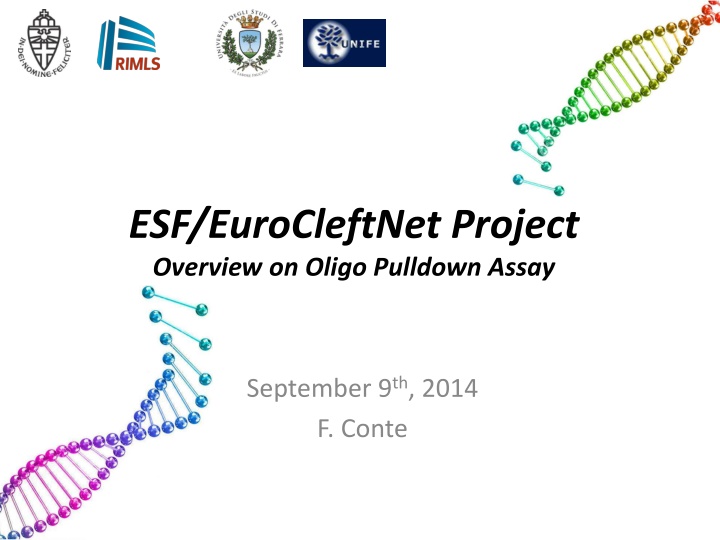
Oligo Pulldown Assay Overview: Selection of DNA-Binding Proteins
Learn about the Oligo Pulldown Assay, a method to selectively detect DNA-binding proteins binding to a specific DNA sequence. The process involves labeling DNA oligos with biotin, using streptavidin-coated beads to recover bound proteins, and analyzing peptides through Western blot or mass spectrometry. Follow steps such as oligonucleotide annealing, bead coating, immobilization of oligonucleotides, nuclear protein extraction, reduction, alkylation of disulfide bonds, and trypsin digestion for successful results.
Download Presentation

Please find below an Image/Link to download the presentation.
The content on the website is provided AS IS for your information and personal use only. It may not be sold, licensed, or shared on other websites without obtaining consent from the author. If you encounter any issues during the download, it is possible that the publisher has removed the file from their server.
You are allowed to download the files provided on this website for personal or commercial use, subject to the condition that they are used lawfully. All files are the property of their respective owners.
The content on the website is provided AS IS for your information and personal use only. It may not be sold, licensed, or shared on other websites without obtaining consent from the author.
E N D
Presentation Transcript
ESF/EuroCleftNet Project Overview on Oligo Pulldown Assay September 9th, 2014 F. Conte
Oligo pulldown assay What is it? Why do we use it? The DNA pulldown assay is a method used to selectively detecting all the DNA-binding proteins which bind a specific sequence of DNA. Typically, the DNA oligo is labeled with biotin, useful after the incubation with the nuclear extract for recovering the oligo and all the proteins bound on it by using beads coated with streptavidin. After the separation, the peptides bound to the sequence are eluted from the oligo and analyzed by: A) Western blot; or B) mass spectrometry.
(0) Oligonucleotide annealing Oligonucleotide structure: ext motif ext Forward biotinylated (min. length 59 nt) Reverse not tagged oligo Annealing buffer + Fw primer + Rev primer Oligonucleotide annealing
Filter plate Beads coated with streptavidin (1) Plate washing membrane (2) Bead equilibration Bead solution Situation in the membrane (after bead addition)
(3) Immobilization of oligonucleotides to beads Oligos Incubation Remaining oligos (without streptavidin) are washed way Result Beads in the membrane with the immobilized oligos
(4) Nuclear extraction incubation Nuclear proteins Gingival keratinocytes Nuclear extract ( 5 mg/ml) Incubation Remaining nuclear proteins (which don t bind to the motif) are washed away Result Beads in the membrane with the immobilized oligos and the proteins (DNA binding factors) bound on the motif
(5) Reduction and alkylation of disulfide bonds Inside the membrane R S S R Because disulfide bonds prevent trypsin digestion (following step), we add: TAEB (100mM) + TCEP (5mM) reduction MMTS (10 mM) alkylation R SH HS R Result
(6) Trypsin digestion Trypsin molecules Trypsin/LysC During incubation Incubation After trypsin digestion, the peptides are present in the supernatant.
(7) Sample collection Filter plate Peptides in the supernatant Vacuum pump New collection plate
Focus on How t I have organize the plate Considering all the wells (8 in my exp): SNP oligo WT oligo (+) AM oligo ( ) WT oligo (+) WT oligo (+) SNP oligo WT oligo (+) AM oligo ( ) SNP WT AM WT WT SNP WT AM
(8) Dimethyl labelling 4 l 4% LIGHT label (CH2O) 4 l 4% MEDIUM label (CD2O) 1 2 To start the labelling reaction, add in every well 4 l NaBH3CN (0.6M) Incubation To stop the labelling reaction, add in every well 16 l 1% ammonia
We mix the samples because we use the combined protocol (9) Sample mixing SNP WT AM WT WT SNP WT AM Result Four merged samples SNP (M) vs WT (L) AM (L) vs WT (M) AM (M) vs WT (L) SNP (L) vs WT (M) In the four wells containing the merged samples, add 5 l 100% TFA
(9) Sample mixing SNP vs WT (fw) SNP vs WT (rev) AM vs WT (fw) AM vs WT (rev) Four merged samples Stage tips with C18 filter Store the loaded stage tips at 4 C indefinitely before elution (mass spec device).
RESULTS from 1stexperiment (12-13/8/2014)
Example How to read a result plot Cloud of spots (in the middle of the axes) contains: (a) the factors which bind equally both the control seq and the mutated seq and (b) the factors which don t bind anything at all. North-West quadrant contains all the binding factors which bind much stronger the mutated sequence than the control. South-East quadrant contains all the binding factors which bind much stronger the control sequence than the mutated one. Outliers (= interesting factors)
Oligo pulldown assay (1st assay, 12-13/8/2013) RESULT 1 Experiment with: WT oligo (control) + oligo containing the SNP
Oligo pulldown assay (1st assay, 12-13/8/2013) RESULT 2 (version A) Experiment with: WT oligo (control) + all mutated oligo (AM) Using the correct statistics, all these outliers are NOT significant!
Oligo pulldown assay (1st assay, 12-13/8/2013) RESULT 2 (version B) Experiment with: WT oligo (control) + all mutated oligo (AM) So Luan has decided to correct manually the plot, just to check the outliers (even if they are not significant)!
Oligo pulldown assay: Because the cloud of spots in the second plot (experiment: WT + AM) is spread along the horizontal axis and it appears different from our expectations, we have decided to repeat this last experiment, in order to get a better plot with significant outliers!
